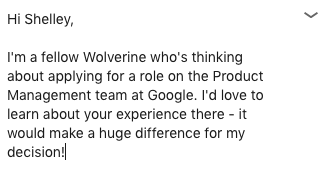Step 1: Review Your Experiences
Before you even start thinking about tech companies, review your past work experience through the following lenses:
Size: Did I do my best work by myself and in small groups - or as part of a much larger effort?
Support: Was I at my best when I was figuring things out on my own or getting lots of support and coaching?
Drive: Was I more motivated by being great at my role (e.g., teaching) or by the mission (e.g., helping others)?
Balance: Did I thrive on long hours and deep bonds at the office or did having more time for life and relationships outside of work keep me fresh?
Once you have a sense of the environment that’s right for you, you can start looking for the same criteria at the tech companies you consider.
Step 2: Tour the Companies
While there are far too many tech companies to review all of them, start with an in-depth look at 18 of the most well-known.
In my free guide, you’ll get a sense of how companies like Google, Uber, and Twitter stack up on things like culture and work-life balance.
And then, to help you generalize trends from these companies to the rest of the tech ecosystem, I’ve put together a crash course on the key factors (B2B vs. B2C, Monopolistic vs. Competitive Markets) that influence tech company culture.
Step 3: Find Similar Companies
Once you have a few companies you’re excited about, you can find similar companies five ways:
Search for the company on LinkedIn and look for the Similar pages listing in the far right column
Search for people who used to work at that company on LinkedIn and see where they now work (e.g., lots of former Square employees now work at Stripe)
Search for the company on Craft and look for their competitors
Google the company using related: - for instance, related:google.com returns other players in the search spage
Start typing on Google “COMPANY vs.” and see what Autosuggest proposes (e.g., “Slack vs.” returns Hipchat and Skype)
Step 4: Add Some Top Employers
In addition to the companies that match your interests, you may want to consider some generally great places to work.
Here are several listings to consider:
Glassdoor Best Places to Work (be sure to filter by company size!)
LinkedIn Top Companies + Top Startups (note, these are only based on employee interest - not satisfaction)
LinkedIn’s top employers from your alma mater
Step 5: Do your Homework!
No matter how great a company seems on paper, make sure it’s actually great for you.
To find out what a company is really like, talk to some former employees. That way, you can make sure they’re not just trying to rationalize their own choices in their assessment.
Here’s how to conduct your due diligence:
Do an Advanced Search on LinkedIn and set Past companies to your desired firm
Pick people who worked close to the team you want to work on and who will want to help you (e.g., fellow alumni and friends of friends)
Connect with them and let them know about your dilemma
Ask them to tell you about the full picture of their experience - good and bad!
Bonus step: Take the Course
If you want more guidance on using LinkedIn to discover and evaluate companies, check out my LinkedIn course.
It’s got a step-by-step process to identify the perfect companies and get your foot in the door at each (including an optional LinkedIn profile review):
Build a strong list of organizations that match your interests
Find insiders who can help you assess your fit and get you a referral for a job
Dig up insider info about the company to ace your interview and increase your negotiation leverage
“Give your LinkedIn knowledge a turbo boost!”

















